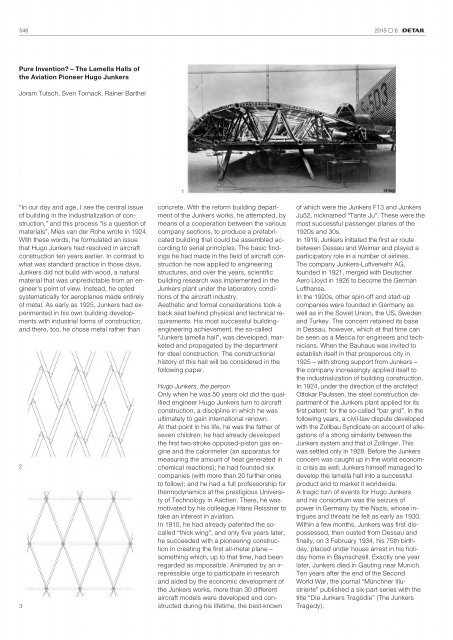Detail english 2015-11-12
Create successful ePaper yourself
Turn your PDF publications into a flip-book with our unique Google optimized e-Paper software.
546 <strong>2015</strong> ¥ 6 ∂<br />
PureInvention?–TheLamellaHallsof<br />
the Aviation Pioneer Hugo Junkers<br />
Joram Tutsch, Sven Tornack, Rainer Barthel<br />
1<br />
“In our day and age, I see the central issue<br />
of building in the industrialization of construction,”<br />
and this process “is a question of<br />
materials”, Mies van der Rohe wrote in 1924.<br />
With these words, he formulated an issue<br />
that Hugo Junkers had resolved in aircraft<br />
construction ten years earlier. In contrast to<br />
what was standard practice in those days,<br />
Junkers did not build with wood, a natural<br />
material that was unpredictable from an engineer’s<br />
point of view. Instead, he opted<br />
systematically for aeroplanes made entirely<br />
of metal. As early as 1925, Junkers had experimented<br />
in his own building developments<br />
with industrial forms of construction,<br />
and there, too, he chose metal rather than<br />
2<br />
3<br />
concrete. With the reform building department<br />
of the Junkers works, he attempted, by<br />
means of a cooperation between the various<br />
company sections, to produce a prefabricated<br />
building that could be assembled according<br />
to serial principles. The basic findings<br />
he had made in the field of aircraft construction<br />
he now applied to engineering<br />
structures, and over the years, scientific<br />
building research was implemented in the<br />
Junkers plant under the laboratory conditions<br />
of the aircraft industry.<br />
Aesthetic and formal considerations took a<br />
back seat behind physical and technical requirements.<br />
His most successful buildingengineering<br />
achievement, the so-called<br />
“Junkers lamella hall”, was developed, marketed<br />
and propagated by the department<br />
for steel construction. The constructional<br />
history of this hall will be considered in the<br />
following paper.<br />
Hugo Junkers, the person<br />
Only when he was 50 years old did the qualified<br />
engineer Hugo Junkers turn to aircraft<br />
construction, a discipline in which he was<br />
ultimately to gain international renown.<br />
At that point in his life, he was the father of<br />
seven children; he had already developed<br />
the first two-stroke opposed-piston gas engine<br />
and the calorimeter (an apparatus for<br />
measuring the amount of heat generated in<br />
chemical reactions); he had founded six<br />
companies (with more than 20 further ones<br />
to follow); and he had a full professorship for<br />
thermodynamics at the prestigious University<br />
of Technology in Aachen. There, he was<br />
motivated by his colleague Hans Reissner to<br />
take an interest in aviation.<br />
In 1910, he had already patented the socalled<br />
“thick wing”, and only five years later,<br />
he succeeded with a pioneering construction<br />
in creating the first all-metal plane –<br />
something which, up to that time, had been<br />
regarded as impossible. Animated by an irrepressible<br />
urge to participate in research<br />
and aided by the economic development of<br />
the Junkers works, more than 30 different<br />
aircraft models were developed and constructed<br />
during his lifetime, the best-known<br />
of which were the Junkers F13 and Junkers<br />
Ju52, nicknamed “Tante Ju”. These were the<br />
most successful passenger planes of the<br />
1920s and 30s.<br />
In 1919, Junkers initiated the first air route<br />
between Dessau and Weimar and played a<br />
participatory role in a number of airlines.<br />
The company Junkers-Luftverkehr AG,<br />
founded in 1921, merged with Deutscher<br />
Aero Lloyd in 1926 to become the German<br />
Lufthansa.<br />
In the 1920s, other spin-off and start-up<br />
companies were founded in Germany as<br />
well as in the Soviet Union, the US, Sweden<br />
and Turkey. The concern retained its base<br />
in Dessau, however, which at that time can<br />
be seen as a Mecca for engineers and technicians.<br />
When the Bauhaus was invited to<br />
establish itself in that prosperous city in<br />
1925 – with strong support from Junkers –<br />
the company increasingly applied itself to<br />
the industrialization of building construction.<br />
In 1924, under the direction of the architect<br />
Ottokar Paulssen, the steel construction department<br />
of the Junkers plant applied for its<br />
first patent: for the so-called “bar grid”. In the<br />
following years, a civil-law dispute developed<br />
with the Zollbau Syndicate on account of allegations<br />
of a strong similarity between the<br />
Junkers system and that of Zollinger. This<br />
was settled only in 1928. Before the Junkers<br />
concern was caught up in the world economic<br />
crisis as well, Junkers himself managed to<br />
develop the lamella hall into a successful<br />
product and to market it worldwide.<br />
A tragic turn of events for Hugo Junkers<br />
and his consortium was the seizure of<br />
power in Germany by the Nazis, whose intrigues<br />
and threats he felt as early as 1930.<br />
Within a few months, Junkers was first dispossessed,<br />
then ousted from Dessau and<br />
finally, on 3 February 1934, his 75th birthday,<br />
placed under house arrest in his holiday<br />
home in Bayrischzell. Exactly one year<br />
later, Junkers died in Gauting near Munich.<br />
Ten years after the end of the Second<br />
World War, the journal “Münchner Illustrierte”<br />
published a six-part series with the<br />
title “Die Junkers Tragödie” (The Junkers<br />
Tragedy).


















